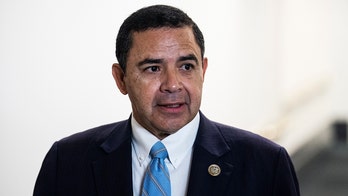
For his first in-studio interview as president, Barack Obama chooses a Spanish-language radio show called “El Piolín por la manana.” A senate candidate sways to mariachis, kicks back tequila and declares to a group of Hispanics that every speech should begin with a shot of the stiff drink. Another politician hosts a breakfast at a Mexican restaurant amid heaping plates of tamales, arróz and frijoles.
In the last frantic week before critical mid-term elections, politicians in tight races across the country are reaching out to one group they think could help them win: Hispanics.
Trying to appeal to Hispanics to gain an edge in an election is nothing new – politicians have been doing it for decades. But this year, the battle over Latino votes has moved into center stage as key races across the country may hinge on the Hispanic vote.
“There certainly a lot of attention being paid to the Latino voter,” said Angelo Falcón, president of the National Institute for Latino Policy. “That’s clear from the publicity and the attention being paid by the political parties.”
One example of the new focus on Hispanics, Falcón said, is the controversial ad by the Latinos for Reform asking Latinos not to vote.
“That could be seen as another indication that they do see Latino vote as important because they are trying to stop it,” he said.
Latinos are the country’s largest and fastest growing minority group. And while anti-immigrant sentiment has become an issue in races nationwide, observers say that most politicians are realizing the 19 million Latinos eligible to vote cannot be ignored.
Democratic National Committee Chairman Tim Kaine has come right out and stated that Hispanics are “critical” to Democratic success on Nov. 2. The DNC has announced it plans to spend $1 million on advertisement targeted to the Hispanic community both regionally and nationally.
The numbers for the Republican National Committee have not been released, but in tossup races in states like California, Nevada and even New Mexico, GOP candidates are actively pursuing Hispanics as well, and in some cases clamoring for Latino attention by pouring record amounts of money into Spanish-language media.
Knocking Back the Tequilas in California
In California, where Hispanics make up one-third of the electorate, Republican gubernatorial candidate Meg Whitman has used her well-funded campaign to pour millions into Hispanic outreach. She has run continuous ads in Spanish language television and radio, splashed Latino neighborhoods with Spanish-language ads on bus shelters and billboards, and opened campaign offices in neighborhoods like East Los Angeles and Santa Clara.
Whitman, who has struggled with her Latino base following the allegation that she knew about her former housekeeper’s lack of working papers, recently said bluntly how important Hispanics are to her race.
“I cannot win this election without the Latino vote,” she said in the past.
Her opponent, Jerry Brown, whose $25 million campaign is dwarfed by Whitman’s $160 million war chest, has made more modest attempts to gain inroads in the Hispanic community.
Brown has pointed to his ties to the community, including marching with former labor leader Cesar Chavez in the beginning of his career and his appointment of Hispanics to high-ranking posts while he was governor three decades ago. He has also pledged to sign the Dream Act, which would allow undocumented high school graduates who go on to college or the military become naturalized citizens.
In the California senate race, Republican Carly Fiorina, waging a tight contest with Democratic Sen. Barbara Boxer, welcomed a group of Hispanic business people by making a tequila toast and declaring:
“I think every speech should begin with a shot of tequila,” she said during the Hispanic 100 Lifetime Achievement Award dinner earlier this month.
Some political analysts say that the main reason Hispanics in California are receiving so much attention this time around is because so many of the races are so close.
“This year I think Latinos are advantaged a little bit in that California has a couple of close races so it increases the attention of both parties to Latinos out here,” said Louis DeSipio, an associate professor of political science at University of California Irvine
Tamales, Rice and Beans in Nevada
In Nevada, Democratic Senate Majority Leader Harry Reid has aggressively tried to woo Hispanic voters, who make up one-fourth of the electorate. In one breakfast with Hispanic leaders, he even tried to court them by serving tamales, rice and beans.
“Latino turnout has the possibility to tip the balance one way or another in the race,” said John Tuman, a political science professor at the University of Nevada Las Vegas.
In recent polls, Reid and his opponent, Republican Sharron Angle, are in a dead heat – and a low Hispanic turnout could push out Reid.
That’s exactly what some say was the motivation behind an ad by a Republican-led group urging Hispanics not to vote. The advertisements, which was supposed to air in Nevada then expand to other states, never ran because Univision declined to broadcast them.
Will a Latina Make History in New Mexico?
In New Mexico, which Hispanics make up a third of the electorate, gubernatorial candidate Susana Martínez is also trying to ride a Latino wave, even though most of the Hispanics in the state are Democrat.
Her opponent, Diane Denish, has tried to boost her profile by appearing alongside former President Bill Clinton at rallies. But Denish has been hurt by Democratic disillusionment in the state, and low approval rating for Gov. Bill Richardson, also a Latino, who appointed her as lieutenant governor. Denish tried to win Hispanic support by choosing a Latino, Brian Colón, as her running mate.
Martínez, who would be the country’s first Latina governor, has not been hurt by her hard-line anti-immigration views and get-tough-on-the-border ads, with analysts saying she’s polling well among Latinos, especially for a Republican. Polls show Martínez, who is trying to capitalize on Richardson’s unpopularity, receiving 30 percent of the Hispanic vote.
Filling the Spanish–Language Airwaves with GOP Ads in Florida
Republican senate candidate Marco Rubio, a Cuban-American, remains the heavily favored candidate in Florida – though his positions are not always popular in the Hispanic community. He favors upholding Arizona’s crackdown on undocumented immigrants and opposes the Dream Act.
Yet, as the only Hispanic candidate in Florida, where Hispanics make up about 12 percent of the electorate, he seems to be the favorite candidate for this demographic. Analysts say it’s because immigration is no longer the No. 1 issue for Hispanic voters.
“While his positions may have hurt him with some Latinos, the overwhelming number of Hispanics are looking for a candidate that can create jobs and turn the economy around,” said Darío Moreno, a political science professor at Florida International University.
Rubio and Rick Scott, the Republican gubernatorial candidate, have given thousands to Hispanic media consultants tasked with tailoring their message to the Latino community, Moreno said. They are also filling the Spanish-language airwaves with ads.
Moreno said the non-Republican candidates in the state, senate candidates Kendrick Meek, a Democrat, and Independent Charlie Crist, and gubernatorial candidate Alex Sink, have not spent as much money on Hispanic outreach.
Popularity translating into power?
Political observers say while Hispanics get attention during election time, it doesn’t translate in growing influence. Falcón of the National Institute for Latino Policy said it’s almost a paradox when you look at how much Latinos get back for all the attention they receive.
“We get a lot of good publicity, but we have highest poverty rate, we have the highest unemployment rate,” Falcón said. “So if we have so much political clout, and we’re doing as well as media says we are doing, then how come we have all these problems?”




